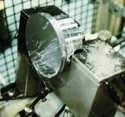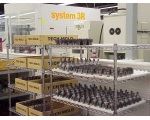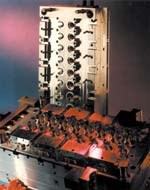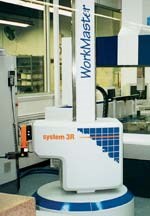Putting Measurement In The Loop
A precision moldmaker aims to boost production and quality by automating metrology.
For the past decade, the main engine of America's economic growth has been a strong and steady rise in productivity. The U.S. Bureau of Labor Statistics reports that, during the period from 1990 to 1998, labor productivity increased in 93 percent of all manufacturing industries. During the same period, 87 percent of manufacturing industries recorded increases in output. As a result, the Unit Labor Cost Index decreased 8.5 percent—from a basis of 100 in 1992 to approximately 91.5 in 2000.
To many people, these are nothing more than upbeat statistics. But to Bill Kushmaul, president of Tech Mold Inc. (Tempe, Arizona), productivity gains represent nothing less than a matter of daily survival for his business. "We're competing against foreign moldmakers who have substantially lower labor costs, says Mr. Kushmaul. "Assuming that all other production costs are equal, the only way that our shop can stay in business is to continue to reduce the labor component in our products. In this competitive environment, we maintain our edge primarily by the creative application of technology."
On the surface, it's difficult to relate Tech Mold's highly successful operation to a precarious market environment. Since he established the firm in 1972, however, Mr. Kushmaul has pursued a proactive strategy that anticipates future needs by continually modernizing and improving the moldmaking process. Summarizing the company's philosophy, vice president Vince Lomax says, "Because the pace of technology is running into the future, you can't walk alongside of it. You must run as fast as you can just to stay current."
In Tech Mold's early days, before fax machines, e-mail and overnight delivery, the shop's Arizona location isolated it from many customers, presenting a definite challenge according to Mr. Lomax. "In order to lure business our way, we had to offer something that our customers couldn't get from their traditional suppliers," he says. That "something" is quality, and the drive for excellence that characterized the shop's early days remains a key element in Tech Mold's current success. To make quality inherent to its increasingly automated process, Tech Mold recently purchased a coordinate measuring machine (Figure 1) manufactured by Carl Zeiss IMT Corporation (Minneapolis, Minnesota).
As a manufacturer of high precision, multi-cavity, injection molds that incorporate fully interchangeable components (Figure 2), Tech Mold typically must maintain tolerances as tight as 0.0001 inch. This level of precision is essential to meet the production demands of clients that include high-volume manufacturers of medical supplies and consumer-goods packaging.
In this line of business, even small process variations can be quite costly. Mr. Kushmaul points out that the cost for his firm to correct even a minor defect in one of its multi-cavity molds is exorbitant. Another example of the substantial stakes involved is a mold for tamper-evident medicine bottle caps that Tech Mold manufactures for a leading pharmaceutical firm. Because of the potential for product liability lawsuits, this mold must be reliable enough to produce a huge quantity of caps without even a single defect.
Experience convinces Mr. Kushmaul that the only way to meet such stringent demands is by rejecting the traditional profile of a mold shop. "Mold shops may have the perception that moldmaking is an old-style, custom-work type of business. The truth is that moldmakers must automate as much as possible to remain competitive and meet customers' needs," he says.
Today, Tech Mold is a state-of-the-art shop where the key processes of EDM, WEDM, high speed machining and grinding have already been substantially automated. "All major pieces of equipment in every department are computer driven, either through direct DNC Ethernet links or custom on-board programming," Mr. Lomax says. "It doesn't take a rocket scientist to figure out that, in today's economy, one must think beyond an 8- or 12-hour day. We now think in terms of 24-hour days, 7 days per week."
Not satisfied with anything less than total automation, the shop has targeted metrology, a function that typically represents a bottleneck in an automated metalworking process. Although Tech Mold is still adapting the new CMM to its manufacturing process, the shop has already redefined its former concepts of measurement and quality.
Automating Inspection
Tech Mold's guiding philosophy is that optimized production requires taking a proven, conventional manufacturing process—then removing the element of human intervention. Measuring with manually operated, touch-trigger CMMs is a slow and variable procedure that periodically creates idle time, as machines and operators await electrodes or first-off part inspections. Furthermore, as the backlog of items awaiting inspection grows, lead times for customers also increase.
By contrast, the Zeiss PRISMO MPS is capable of rapidly measuring a large number of parts and electrodes, while maintaining precise, repeatable accuracy. Tech Mold uses the CMM's scanning function to measure prismatic shapes, including planes and holes. For the majority of measurements, however, the shop employs the CMM's rapid, touch-probing function (Figure 3).
To illustrate these capabilities, senior mold designer Brett Black cites the example of an insert for one of the shop's multi-cavity molds that incorporates 320 separate dimensions. "The energy required to make all the calculations involved in surface plate measurements, compounded with the time required to physically configure setup fixtures for 320 dimensions is staggering," says Mr. Black. "The CMM can complete all these measurements in one setup and record the data in 12 minutes." Although this particular part is very complex, Mr. Black estimates that the CMM run time for an average part is approximately 5 minutes.
Although additional time is required to program the CMM for measuring a particular part, this represents a one-time investment, because the inspection program is saved. Furthermore, when the CMM is served by a robot, it can operate unattended 24 hours per day. This substantially expands the shop's overall production capacity.
In a highly automated shop such as Tech Mold, CNC machining typically creates a substantial backlog of items needing inspection at the start of each daytime shift. For EDM work alone, Mr. Kushmaul estimates that his shop uses more than 30,000 electrodes per year (Figure 4). This is an important reason why automating the measurement function is critical to improving the shop's productivity.
In-process measurement, however, is more than just a boon to production speed. Conventional, touch-trigger CMMs require a substantial amount of operator manipulation that can lead to measurement errors. Given the high-precision nature of this shop's work, automatic metrology is essential to ensure repeatable accuracy throughout the entire manufacturing process. Therefore, just as automation has become essential to the shop's metalworking functions, the drive to automate measurement is viewed as a matter of necessity rather than choice.
According to Mr. Black, Tech Mold's inspection routine begins by inspecting the first-off part and automatically generating the machine offset and compensation moves. "Then, we check the second piece to validate these corrections," he says. "Next, we machine all the parts and load them into the storage carousel. This same procedure will occur for many different components from many different machines throughout the day. At the end of the day, we initiate a batch inspection program that will perform a 100-percent inspection of all these details overnight. The next morning, we automatically generate an Excel spreadsheet with all the data for review."
A Matter of Trust
A significant aspect of Tech Mold's process improvement involves learning to trust computer data and CMMs instead of paper drawings and human measurements. Although conventional methods of measurement put faith in gage blocks and the inspector's keen eye, current technology increasingly encourages metalworking shops to accept virtual data and "softgauges."
Tech Mold has already moved far enough in this direction that the shop has abandoned paper drawings entirely. "One must look at ways to remove all variability. We've found it necessary, therefore, to transport the solid model directly from our engineering department right down to the computers on the shop floor," Mr. Lomax says.
Mr. Black and systems programmer Elango Ramanathan are currently working toward the shop's ultimate goal of fully automated, closed-loop measurement and analysis. The payoff for initiating this "data-to-steel" system is twofold. First, according to Mr. Black, important data cannot be lost in translation from 2D drawings to 3D solid models. "Working in a drafting environment introduces unnecessary errors into any measurement process," he adds. "The reason for this is simple. A high percentage of the numbers on blueprints are not nominal numbers. The significant digit that you don't see is rounded off, either up or down. Measuring directly to CAD data eliminates this error, making the measurement more accurate to design intent."
Second, the potential for manual measurement errors is eliminated. Tech Mold's vice president of operations Karl Szanto says, "Instead of the previous role of simply identifying unacceptable parts, the CMM can now assist with the overall manufacturing process to prevent errors. It used to be that, when a conflict arose between human and machine measurements, the machine was our first suspect. Now, we tend to accept the machine data and recheck the manual measurement."
This represents a significant shift in the measurement paradigm. It also allows Tech Mold to reach for the uppermost level of design integrity—where the solid model includes data that defines the part's manufacturing plan, CAM programming and routing information. This provides all the information necessary to automate the part's manufacturing process.
Based on Tech Mold's early experience, the automated CMM not only maintains a degree of accuracy comparable to careful human measurements, but it does so repeatedly and in only a fraction of the time. Describing the shop's initial prove-out process, Mr. Ramanathan says, "The CMM beat our measurement guru in speed of measurement, as well as in generating a complete data analysis. The CMM's report can be interpreted at a glance. Any dimension that falls outside the tolerance is printed in one column, while in-tolerance dimensions are divided into two additional columns–one for those that fall on the high side, and another for those that border on the low side. Another column indicates the mean measurements." This analysis enables machine operators to make subtle adjustments to bring borderline measurements in line with the mean values.
The CMM's capabilities also present some additional options. It's not uncommon for the clients of some mold shops to furnish plastic parts without blueprints, requesting duplication or modification. The CMM's speed in measuring part surfaces and generating CAD/CAM data permits the user to quickly create parts via reverse engineering. Additionally, final-inspection data for product documentation can be generated much faster than in the past. The CMM's ability to automatically create or verify data at key points in the production process places metrology, for the first time, at the center of a closed-loop manufacturing system.
The Ties That Bind
Having the latest metalworking and measurement equipment, however, is only part of the equation. Given the greater throughput capacities of CNC machines, ensuring an efficient flow of electrodes and mold components during the production process is essential to optimizing the shop's operations. Tech Mold accomplishes this by using robots to move workpieces among various machines. To load and unload items from machines, the shop employs WorkMan and WorkMaster robots (Figure 5) manufactured by System 3R (Totowa, New Jersey) Each robot incorporates a workpiece changer that operates in conjunction with an electrode changer. The system includes rotary storage magazines that hold electrodes and mold components. The robot system's control software enables operators to load the magazines with parts and electrodes for several different jobs, then run the jobs unattended for substantial periods of time.
To maintain the level of accuracy required for automated production of precision molds, workholding cannot be a variable in the process. Tech Mold addresses this concern by using System 3R's Macro Pallet system. This system eliminates manual fixturing and ensures precise positioning of workpieces as they move through the production process. Each mold insert or EDM electrode is mounted onto a separate pallet that incorporates the system's XYZ reference system. In this way, workpieces can be automatically transferred among various machines with no loss of accuracy.
The robots and precision workholding system represent the glue that holds Tech Mold's automated manufacturing scheme together. Although the shop has been using the Macro system for many years to automate machining operations, it has now become an enabling technology for integrating the CMM into the process. By creating robotized manufacturing cells with measurement and quality in the loop, the shop is moving closer to its goal of 24-hour-per-day, 7-day-per-week production. This ultimately will allow Tech Mold to realize the same production accuracy and repeatability in a deserted shop at 2:00 AM on Saturday night that it now achieves in the middle of a busy workday.
Different Strokes
Tech Mold's EDM technique differs from that of shops producing molds that incorporate small numbers of cavities. The shop commonly makes electrodes in sets of at least 70. For this reason, Tech Mold uses "standard-orbit undersizing" for approximately 90 percent of its EDM burns. In this process, the electrode drops directly to the desired depth, then moves with a spiral motion, in a single plane, to bring the burn out to size. By contrast, in a "spherical burn," these spiral movements are executed in many different planes during the process.
To EDM any specific form, standard-orbit burn time is less than spherical burn time—but the programming time for standard-orbit burns is greater. Because of the large number of burns his shop makes, Mr. Black says, "The extra time to define and program these electrodes is more than recovered in reduced burn time." In Tech Mold's developing scheme, the CMM's ability to communicate mean tolerance information directly to the EDM is a crucial element to ensure accuracy of final burns.
The Automated Future
As Tech Mold continues to integrate the CMM into its production process, the shop is moving closer to its goal. "Our plan is to make the CMM a seamless part of our manufacturing cycle," Mr. Lomax says. "We envision a day when a robot will place a component on the CMM, and the CMM will deliver an electronic report directly to the machine tool." When fully developed, Tech Mold's production system will continuously monitor all dimensional data and automatically adjust metalworking machines to maintain reliable precision. "Although the champagne hasn't been cracked open yet," Mr. Lomax says describing the shop's progress to date, "we have declared victory."
With more than 130 ambitious and highly skilled employees, Tech Mold's experience makes a strong statement that automation and employment are compatible values. Indeed, without continuously and aggressively improving its manufacturing process, the shop could never have grown to its current dimensions.
By itself, the high-precision moldmaking enabled by new, creatively applied technology exemplifies the surging productivity that underlies a strong economy. But in a larger sense, the moldmaker's work has a substantial spin-off effect. By providing high quality production tools to various U.S. industries, Tech Mold helps domestic manufacturers produce better products at lower unit costs. In a nutshell, this is the core advantage that Mr. Kushmaul and other forward-looking moldmakers provide to their customers. It also represents a small but significant part of the continuing American success story in the global marketplace.
Related Content
How To Calibrate Your Calipers
If you’re interested in calibrating your own digital, dial or Vernier calipers, here are some steps to take to make sure it goes off without a hitch.
Read MoreParts and Programs: Setup for Success
Tips for program and work setups that can simplify adjustments and troubleshooting.
Read MoreHow to Calibrate Gages and Certify Calibration Programs
Tips for establishing and maintaining a regular gage calibration program.
Read MoreUnderstanding Errors In Hand-Held Measuring Instruments
Different instruments (and different operators) are prone to different errors.
Read MoreRead Next
Consider Closing The Loop
Looking for a way to reduce process variability, speed setup, simplify your operation? Automatic measurement and machine compensation (Closed Loop Machining) may be something to consider. Here's a shop where it's making a difference.
Read More3 Mistakes That Cause CNC Programs to Fail
Despite enhancements to manufacturing technology, there are still issues today that can cause programs to fail. These failures can cause lost time, scrapped parts, damaged machines and even injured operators.
Read MoreThe Cut Scene: The Finer Details of Large-Format Machining
Small details and features can have an outsized impact on large parts, such as Barbco’s collapsible utility drill head.
Read More






.jpg;width=860)














.png;maxWidth=300;quality=90)














